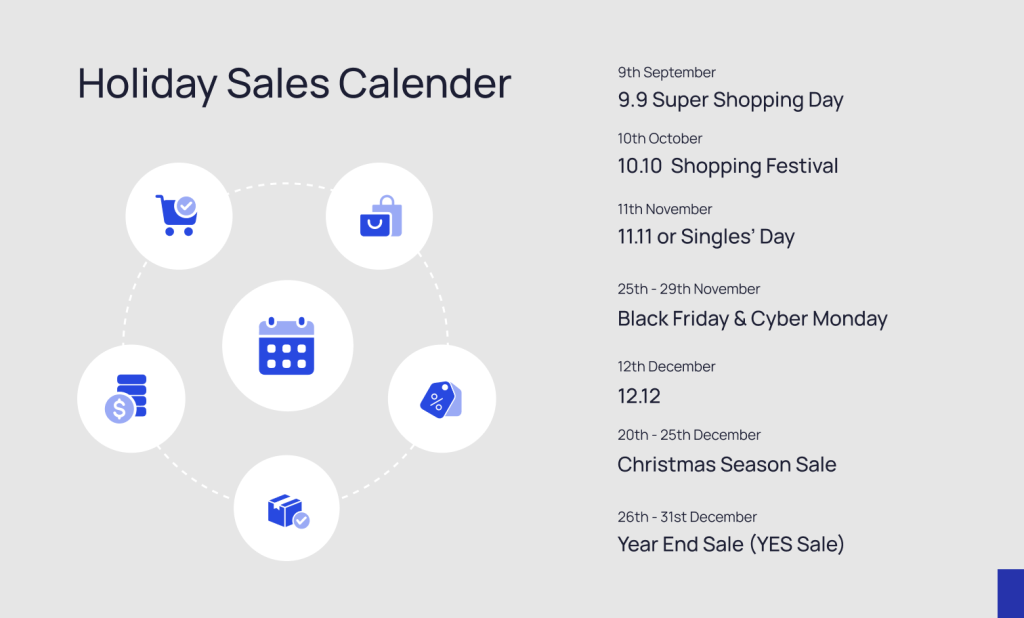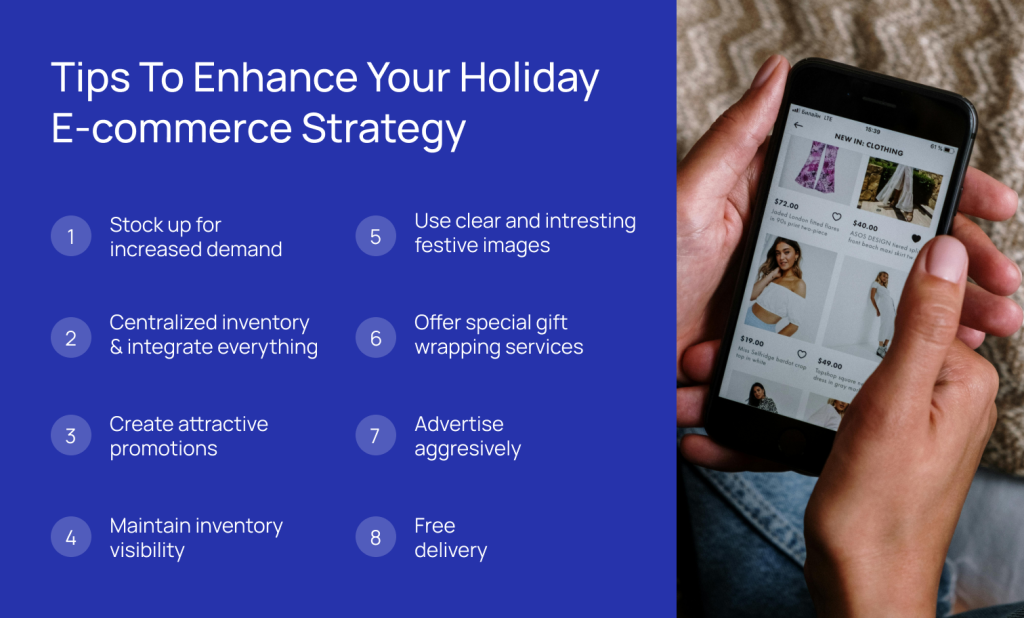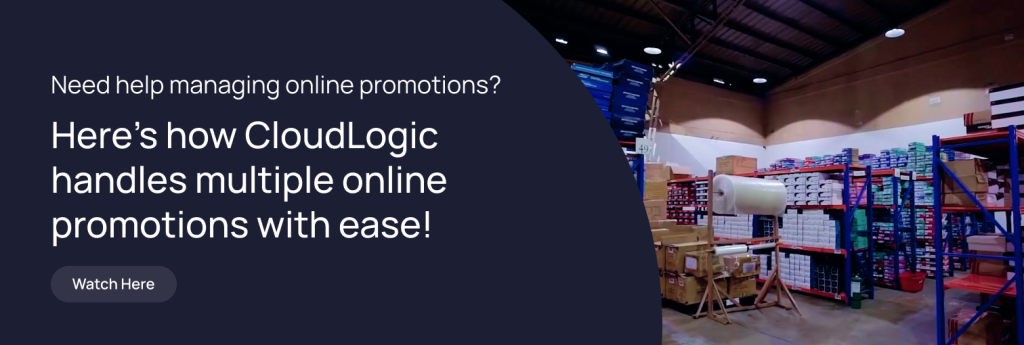
1. Introduction
The holiday season or Q4 is the busiest time of the year for the retail industry across the globe. With festivities and celebrations coming up during the final 3 months of the year, consumers anticipate shopping festivals, mega sales, deals, promotions, and bargains so they can shop for gifts for family and friends.
Businesses also enjoy this period as it helps them complete sales quotas before the year ends. For the longest time, the final quarter has been a profitable period for offline stores and now online retail is also seeing a sizeable increase in revenue during this season.
That means you must sharpen your holiday e-commerce strategy for a successful Q4!
2. How Much Do Holiday Sales Affect E-commerce? – Quick Stats
Holiday sales continue to be a crucial period for e-commerce businesses worldwide, consistently setting new benchmarks for online spending and driving significant growth. Here’s a look at how key regions performed during recent peak seasons:
- Southeast Asia: Shopee saw a 23% revenue increase in Q4 2023 [1], largely due to successful shopping events. The 11.11 sale alone hit $1 billion in Gross Merchandise Value (GMV) within a single day.
- The United States: In 2024, consumers spent a record $241.4 billion online from November 1 to December 31, an 8.7% year-over-year (YoY) increase [2]. Cyber Week (Thanksgiving to Cyber Monday) generated $41.1 billion online, up 8.2% YoY.
- Europe: During BFCM (Black Friday and Cyber Monday) last year, package volume surged by 93.7% compared to the pre-BFCM period [3]. E-commerce sales in Europe also increased by 8% on Black Friday and 10% on Cyber Monday [4].
- The Middle East: During the last White Friday(a sales event similar to Black Friday), smartphone in-app purchases increased by 74% compared to average Fridays in November, a sharp rise from 24% in the previous year [5].
- Australia: Australia Post delivered nearly 103 million parcels during last year’s peak season (November 1 to December 31). Cyber sales weekend, in particular, was a clear highlight, as online purchases grew by 7.8% YoY [6].
3. Holiday Sales Calendar
Besides the well-known and much-awaited Black Friday sales, there are many other festive sales to take advantage of during Q4. We’ve prepared a calendar of the most anticipated festive season sales during Q4 across South East Asia, Europe, the Middle East, and Australia.

a. 11.11 or Singles’ Day
Singles Day or Double 11 (11.11), was initially a 24-hour flash sale, but is now a multi-day extravaganza, ending at midnight on November 11. The sales event was created by Alibaba in 2009 and recently(2024), the marketplace announced “robust growth” in sales and a “record number” of shoppers. A whopping 45 brands, including Apple, Haier, Midea, and Xiaomi, each achieved over 1 billion yuan ($138.62 million) in GMV [7]. Besides China, the 11.11 sales are a big hit across many countries in Southeast Asia.
b. 9.9 Super Shopping Day
Shopee’s 9.9 Super Shopping Day is a significant annual sales event, mirroring the 11.11 sale. Held on September 9th, it features extensive discounts and consumer perks. In 2024, Malaysian Shopee Live sellers achieved a 6.5 times sales uplift compared to a typical day, driven by nearly 100 million user interactions [8]. The 9.9 sales continue to be a major success across various online retail platforms and countries in Southeast Asia.
c. 10.10 Shopping Festival
The 10.10 Shopping Festival is another prominent double-digit sales event in Southeast Asia, widely embraced by e-commerce platforms like Lazada and Shopee. For 2024, Shopee’s 10.10 Brands Festival, which ran from September 26 to October 13, emphasized a “Lowest Price Guaranteed” promise and offered 120% coins cashback [9]. Lazada also actively participated in the 10.10 sales in 2024, offering various discounts, vouchers, and free shipping.
d. Black Friday and Cyber Monday
Black Friday is a popular festive sale across the world. While still smaller in comparison to the US, we see several countries in the UK, France, Australia, the Middle East, and Southeast Asia hosting annual Black Friday and Cyber Monday sales. These events are prime opportunities to put any holiday promotion ideas into action, adding to the shopping excitement during the festive season and serving as great customer magnets.
e. 12.12
This is the last of the double-digit sales events for the year. It was introduced and is held by Lazada for its small to medium-sized sellers and retailers. It is a popular sales event in Singapore and one of the biggest e-commerce events in Indonesia.
f. Christmas Season Sale
In Europe, Christmas and holiday season sales are sizeable contributors to e-commerce revenue. Based on figures from Visa for the 2024 holiday season, British retailers reported a 2.3% year-on-year rise in spending for the seven weeks to December 20th in the run-up to Christmas [10]. Within this period, online sales led the increase, up 6.1%.
g. Year End Sale (YES Sale)
Year End Sales vary from platform to platform and as it isn’t a fixed sale like Black Friday or double-digit sales, it is more flexible in terms of starting dates and sales duration. They serve as the final opportunity for last-minute gift purchases, significantly contributing to Q4 sales. Implementing strategic holiday marketing ideas during this period can effectively capture these buyers.
4. Common Holiday E-commerce Challenges to Avoid
As e-commerce businesses like yours gear up for the bustling Q4 holiday season, avoiding these challenges is key to ensuring a smooth, profitable, and stress-free festive period.
a. Underestimating demand and inventory planning
One of the most critical errors is failing to accurately forecast demand, leading to stockouts or, conversely, overstocking. Stockouts result in lost sales and frustrated customers, while excess inventory ties up capital. Both highlight the need for robust inventory visibility and planning. Without a centralized view of stock levels across all channels and warehouses, your business risks disappointing customers with “sold out” messages or shipping delays.
b. Logistical bottlenecks and shipping delays
The sheer volume of holiday orders often overwhelms shipping carriers and internal fulfillment operations. This can lead to significant delays, increased customer complaints, and a tarnished brand reputation. Neglecting to optimize warehouse efficiency, streamline picking and packing processes, and establish strong relationships with reliable shipping partners can quickly create logistical chaos.
c. Website performance issues and technical glitches
A sudden surge in website traffic during peak sale periods (like Black Friday or 11.11) can crash an unprepared e-commerce platform. Slow loading times, checkout errors, or broken links may deter potential customers, causing high bounce rates and abandoned carts. Ensure your website infrastructure is scalable, secure, and rigorously tested under heavy load.
d. Intense competition and discounting wars
The holiday season is a battleground for consumer attention as competitors aggressively advertise and offer deep discounts. A common mistake is racing to the bottom on pricing without considering profitability or differentiating value. Instead, strategically plan promotions and pricing by prioritizing unique bundles, exclusive offers, or superior customer experiences. For optimized product offerings, a strong category management strategy is key.
e. Neglecting customer service and communication
With increased order volumes come increased customer inquiries and potential issues. Inadequate customer support, slow response times, or unclear communication regarding order status and shipping can severely impact customer satisfaction and retention. Proactive communication and efficient resolution of queries are important for a positive holiday shopping experience.
f. Inadequate return management processes
While sales are the focus, the post-holiday period often sees a spike in returns. An inefficient or customer-unfriendly return policy and process can negate the positive impression of a successful purchase. You should ensure return procedures are clear, simple, and well-communicated to maintain customer loyalty.
By proactively addressing these common challenges, your e-commerce business can fortify operations, enhance the customer experience, and truly leverage the Q4 holiday season for maximum growth and success.
5. Top 8 Holiday E-commerce Strategies for Q4 Success
As you know the holidays or festive season are a golden opportunity to increase online sales. If you’re counting on your Q4 to complete sales targets or simply end the year with a bang, you need to strategically approach the Holiday or Festive season.
All consumers love a good bargain, but it’s not the only factor they consider when shopping during the holidays. They want a memorable experience. There’s also the fact that you’ll be up against some intense competition.
So, how do you plan to stand out and capture customers?
In this section, we’ve covered everything you need to do to get your online stores holiday-ready. Consider this your essential e-commerce holiday checklist so you can effectively engage customers, deliver great experiences, and clear out those virtual shelves. Read on to find out where you can tweak your e-commerce promotion strategies for a successful Q4 and more revenue this festive season!

a. Stock up for increased demand
A customer influx during special season sales is a given. So preparing for increased demand is a must. Scoping for products only to realize they are sold out is a huge turn-off when shoppers are set on making a purchase. No one wants to wait long for a product to be restocked especially for an item they intend on gifting.
To avoid stockouts and back-orders, take note of stock levels and plan your inventory replenishment in advance. Implement technology to centralize your inventory across your warehouses or fulfillment centers so you can dispatch orders to customers from any of your closest storage locations based on inventory availability.
b. Centralize inventory and integrate everything
With hundreds of orders coming in every day, you want to ensure quick processing, picking, and fulfillment. This is possible with integrated marketplaces and online stores, inventory centralization, and carrier integrations.
With a powerful Order Management System (OMS) and Warehouse Management System (WMS) offering a broad range of platform and carrier integrations, you can easily synchronize your orders and inventory, process orders, and ensure delivery partners are notified to pick up parcels for quick delivery.
But simply centralizing and integrating with different partners and platforms isn’t enough to enhance your holiday e-commerce strategy for a successful Q4. You must test all your integrations to ensure there is no disconnect that could backlog orders or worse, cause them to go unnoticed.

c. Create attractive promotions
Everyone loves a good discount, and that’s exactly what they’re looking for during festive sales. But be wise with your product pricing. If you’re unsure of how low you should go with your deals and holiday promotion ideas, scope the competition.
Use competitive platforms to spot competing brands and products and identify how they are pricing and promoting their products and how much engagement they’re receiving for their promotions.

d. Maintain inventory visibility
If you plan to offer special packages like bundles of complementary items, buy-one-free-one promotions, and even exclusive vouchers to ensure repeat sales, make sure you have clear visibility of your inventory to avoid mixups.
When you offer custom package selections, for example, 2 T-shirts with different color combinations to choose from, you must precisely pack the chosen items. With a WMS in place, you can track down the exact product variations as per order in your warehouse and ensure it’s shipped to the correct customer with auto-generated shipping labels.
e. Use clear and interesting festive images
Humans are very visual creatures, so take this opportunity to create images that can pique the interest of consumers to keep them browsing through your online store. You can even jazz up your product listings by festooning your product images with festive decorations.
Also, you can customize your greeting message on your landing page to suit the holiday mood, and don’t forget to leave a nice message with a vibrant festive image in the package for customers to feel a personal connection.

f. Offer special gift-wrapping services
The holiday season is all about gift giving and modern shoppers love convenience, which is one of the main reasons we choose to buy online. However, part of the fun of receiving presents is unwrapping them and many physical stores offer this service during the festive season.
To keep customers happy and excited to buy from you, offer gift wrapping as an add-on service and make their online shopping easy and hassle-free. It’s this kind of value-added service that keeps your users coming back and the key to great e-commerce strategies for a successful Q4.
g. Advertise aggressively
Advertising your exciting discounts, deals, and product combinations can attract more customers to your online products. You can post links to your products and store on social media, send them out in emails, or over WhatsApp to existing customers. You can even use marketplace ad banners or Google ads to attract customers to your products on sale.
Another great way to advertise your promotions and discounts is through coupon codes that you could leave in the packaging of products your customers’ order. These can be exclusive discounts only for repeat customers.

h. Free delivery
One of the most classic, yet effective, holiday marketing ideas is offering free delivery. Most online shoppers would not hesitate to drop a significant amount on the item itself but cringe when a delivery fee is charged. Prevent this from happening by waiving delivery fees. After all, it’s the season of goodwill and your happy customers will definitely be returning for more shopping if you go the extra mile for them.
6. Software to Power Your Holiday E-commerce Strategy
Beyond strategic planning, successfully navigating the complexities of Q4 holiday sales requires the right technological backbone. Leveraging cutting-edge tools and platforms can automate processes, provide critical insights, and enhance every aspect of your holiday e-commerce strategy. Consider integrating the following:
- Order Management Systems (OMS): A robust OMS helps centralize orders from multiple sales channels (marketplaces, webstores, social commerce). During the holidays, an OMS ensures that orders are captured, processed, and routed efficiently, preventing overselling and providing a unified view of customer purchases. Look for systems that offer seamless integration with your other e-commerce platforms, tools, and shipping carriers.
- Warehouse Management Systems (WMS): Prevent logistical bottlenecks and ensure rapid fulfillment with a sophisticated WMS. It optimizes warehouse layouts, guides picking and packing processes, manages inventory locations, and facilitates efficient dispatch. It’s also capable of handling high volumes, integrating with your OMS and shipping partners for timely SLA management during peak seasons.
- Inventory Management Software: Advanced inventory management software provide real-time visibility across all your stock locations, enable accurate demand forecasting, and automate replenishment alerts. This helps prevent stockouts, minimizes carrying costs, and ensures popular items are always available, even during fluctuating holiday demand.
- Digital Shelf Analytics Software: Digital shelf analytics platforms allow you to monitor competitor pricing, promotions, product availability, and customer reviews. This intelligence empowers you to adjust your strategies dynamically, ensuring your offers remain attractive and competitive.
- Parcel Tracking Solutions: Software that provides end-to-end parcel tracking allows you to monitor shipments proactively and offer customers real-time updates through branded tracking pages. This transparency significantly reduces customer inquiries, builds trust, and enhances the overall delivery experience.
7. Holiday E-commerce Strategy Case Studies
How have real businesses successfully navigated the holiday e-commerce landscape (or periods of immense demand)? These examples demonstrate the power of strategic planning, technological adoption, and customer-centric approaches in achieving remarkable Q4 success.
a. Kanmo Group
Kanmo Group, a leading multi-brand retailer, faced the challenge of disparate systems hindering a unified customer experience, especially crucial during high-volume sales periods. By implementing Anchanto’s OMS, they improved their omnichannel capabilities, ensuring readiness for seasonal surges.
With Anchanto’s technology, they managed to:
- Gain real-time visibility across all online and offline channels
- Centralize catalog management for a consistent multichannel experience
- Synchronize stock to reduce overselling and provide accurate updates during promotions
- Streamline order routing and fulfillment processes to maintain delivery speed
- Scale operations seamlessly to manage increased demand without compromising service
- Launch promotional campaigns by allocating desired inventory to specific marketplaces and controlling pricing centrally
b. ERHA
ERHA, a prominent Indonesian health and beauty brand, struggled with manual processes that limited their ability to fulfill a rapidly growing number of daily orders, a common hurdle during peak holiday sales. They sought a solution to drastically boost their fulfillment capacity and efficiency.
By implementing Anchanto WMS and OMS, ERHA successfully:
- Boosted their daily fulfillment rate from 300 to over 1000 orders, demonstrating robust scalability for high-demand periods
- Improved stock take accuracy from approximately 50% to 85% by eliminating manual assessment processes
- Automated and streamlined their picking, packing, and dispatch processes
- Achieved error-free and faster order processing, reducing error rates from above 5% to 1%-1.5%
- Enabled better promotion management through centralized catalog capabilities
c. Cedro
As a 3PL and fulfillment provider, Cedro’s ability to deliver accurate orders is paramount, particularly when handling the increased volume and pressure of holiday shopping. They identified high picking error rates as a critical challenge impacting client satisfaction.
With Anchanto’s WMS and OMS, Cedro achieved:
- A dramatic reduction in picking error rates to just 0.1%, ensuring near-perfect order accuracy for every shipment
- Enhanced overall warehouse efficiency and speed in processing orders
- Improved inventory control and traceability, minimizing overselling and cancellations
- Streamlined order editing, allowing immediate changes to orders before picking
- Managed pre-order promotions, leveraging the OMS promotions module to sell products in transit and ensure continuous availability for customers
8. Final Thoughts
Every holiday season is an opportunity. How you leverage it will determine your Q4 success. The best way to begin is to identify which sales are most lucrative for your business and create a robust e-commerce holiday checklist. Ensure you have enough time to activate your optimized sales strategy with the tips we’ve listed and then take the time to review your performance at the end of the sale.
For the best results this holiday season, consider implementing SaaS technology to manage your online retail better. It will help you maintain a connected e-commerce environment for total visibility, flawless performance, and superior backend optimization.
Reach out to our experts to know more.
FAQs
1. Are the holidays a good time to start an e-commerce business?
The holiday season (Q4) is globally recognized as the busiest and most profitable period for retail, significantly increasing revenue for online businesses. However, it is also important to note that this is a highly competitive and logistically demanding period, so thorough preparation is a must before launching your business to reap the benefits of this season.
2. When should I start preparing my holiday e-commerce strategy?
It’s important to start preparing your holiday e-commerce strategy several months in advance. Allocate sufficient time to activate your sales strategy, including planning inventory replenishment and stocking up for increased demand. Given that some sales events like 9.9 and 10.10 occur in September and October, preparation should begin much earlier than Q4 to ensure readiness.
3. How do I manage logistics and fulfillment during the holiday rush?
To effectively manage logistics and fulfillment during the holiday rush, make sure your business:
- Has ample stock to meet increased demand, with centralized inventory across various warehouses.
- Utilizes robust Order Management Systems (OMS) and Warehouse Management Systems (WMS) with extensive integrations. This helps synchronize orders and inventory for quick processing and timely delivery.
- Maintains clear visibility of your inventory, especially for bundled or custom packages, to avoid errors.
4. What channels should I prioritize for holiday e-commerce marketing?
For holiday e-commerce marketing, it’s best to advertise across multiple channels for maximum reach and impact. Key channels include social media platforms, email marketing, marketplace ads, Google ads, and others.
5. Which e-commerce strategies are most effective for Q4 sales?
These are some effective e-commerce strategies to get your online stores ready for a successful Q4:
- Stock up for anticipated demand and centralize your inventory.
- Integrate powerful Order Management Systems (OMS) and Warehouse Management Systems (WMS) for efficient processing.
- Create attractive and competitive promotions and deals.
- Maintain clear inventory visibility, especially for custom bundles.
- Use clear, engaging, and festive images for product listings and landing pages.
- Offer special add-on services like gift-wrapping.
- Promote your offerings widely across various marketing channels.
- Waive delivery fees, as this is a major incentive for shoppers.
References:
[1] – Retailasia.com – Shopee hits record sales during 11.11 event
[4] Digitalcommerce360.com – Ecommerce Holiday Season: Black Friday, Cyber Monday and Cyber Week
[5] Communicateonline.me – WHITE FRIDAY 2024: MOBILE IN-APP PURCHASES SURGE BY 74%
[6] Auspost.com.au – How Aussies shopped during the 2024 peak season
[7] Reuters.com – China’s Singles’ Day wraps up super-sized sales event with volume, shopper growth
[9] Minimeinsights.com – Shopee 10.10 Brands Festival: Lowest Price? We Guarantee It
[10] Bmmagazine.co.uk – UK Christmas shopping rebounds with higher spending on high street and online
